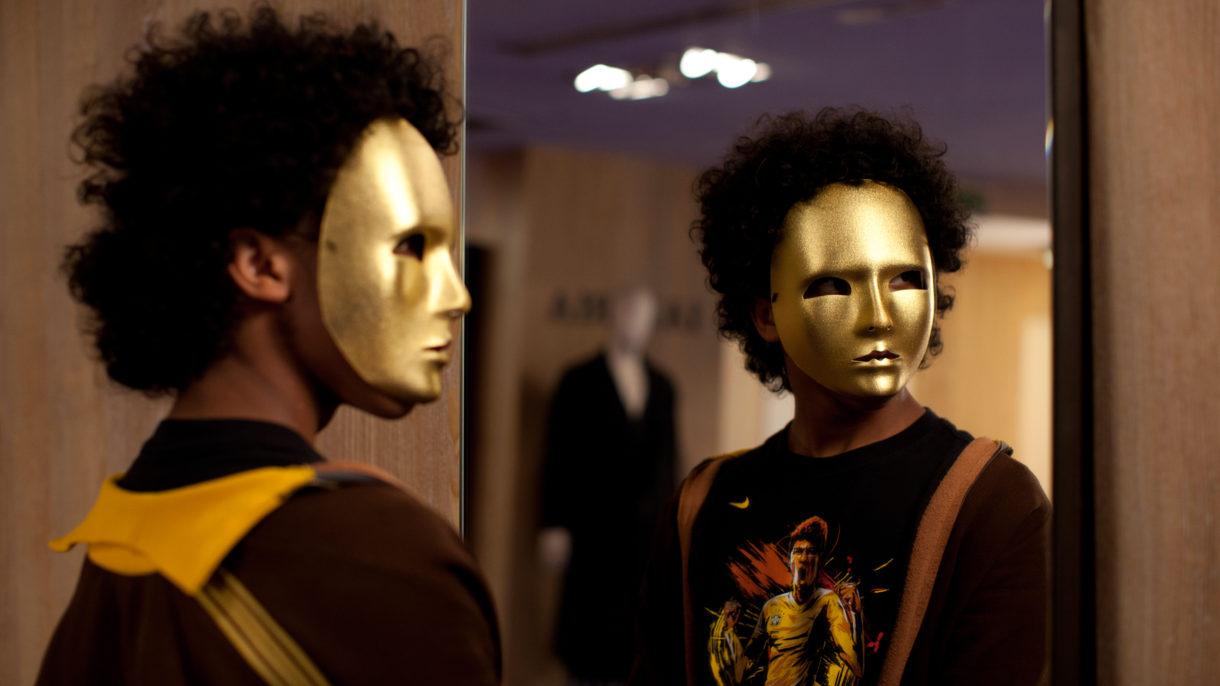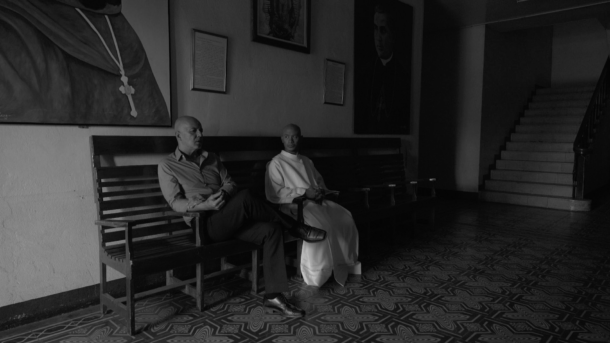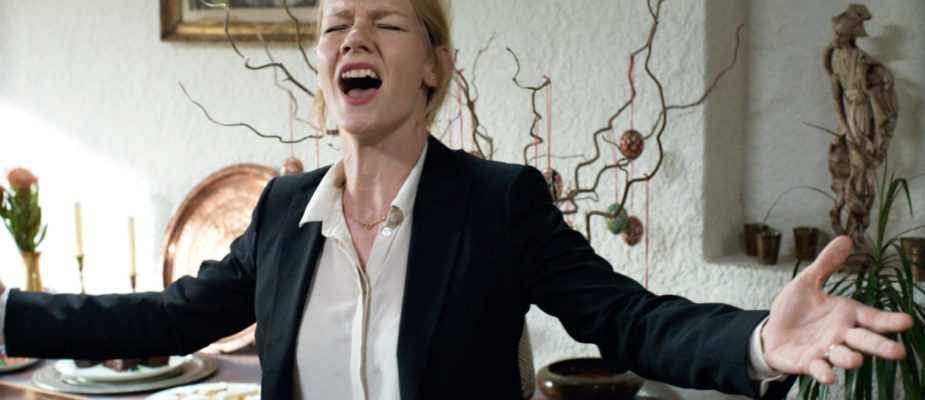As unambitious as it may sound, I really only had one hope for this year’s Toronto International Film Festival: see writer-director Maren Ade’s Toni Erdmann (2016). As simple a task as this might sound–especially for a festival featuring Oscar hopefuls La La Land and Manchester By the Sea, among many others–I was facing an arrival time after the Press & Industry screening, and had convinced myself that the 162-minute German comedy would be one of the hottest tickets in town. In my defense, Toni Erdmann did just screen to an almost unheard of level of acclaim at this year’s Cannes Film Festival–and the public advance-sale tickets were gone before I got the chance to reserve one. Well, rest assured that this privileged film programmer got his wish and all is now right with this wonderful world in which we live.
The third feature by the thirty-nine year-old Ade, after The Forest for the Trees (2003), her very promising diploma film, and Everyone Else (2009), the filmmaker’s critical breakthrough and one of the absolute highlights of the twenty-first century Berlin School, Toni Erdmann builds on the comparatively more dramatic latter especially in its considered observation of an at times tortured relationship–in this instance, a father and daughter. Peter Simonischek stars as Winfried, a retired piano teacher with a proclivity for pranking just about everyone with whom he comes in contact, from the unsuspecting delivery man in the film’s opening scene, to the birthday party guests he greets with Joker face paint–and the crooked and discolored false teeth that he carries with himself wherever he goes. Sandra Hüller, meanwhile, plays his adult daughter Ines, an upwardly mobile oil-industry consultant located out of Bucharest, Romania, who spends almost every waking hour attached to her cell phone. Suffice it to say that the two differ substantially in personality, if not also as symbols of their respective generations–and even of old and new European and German values.
In an effort to spend time with Ines, Winfried arrives unannounced at his daughter’s Bucharest office–in another gag featuring what will become the middle-aged man’s trademark hairpiece. As one awkward encounter gives way to another, first with Winfried identifying as himself, and subsequently in the fictitious businessman role he’s invented for himself as Toni Erdmann, Ade frames both the actor’s antics and also the often horrified reactions of Ines and her business associates in hand-held, subtly twitching long takes, which the director assiduously holds past the point of discomfort. This indeed is a film of reactions, above all, with Ines’s focalized as she is made to relive an exaggerated version of adolescent embarrassment (that might be excruciating if it was not so funny, nor Winfried so fun-loving). It is also, certainly, a film of performance, not only Winfried’s masquerade as the title character, but also Ines’s in her professional life.
The pivotal moment for the film’s female lead comes in the midst of another of Winfried’s (admittedly less convincing) performances: as the German ambassador to Romania. Arriving with Ines at the home of an acquaintance he meets under this guise, Winfried compels his daughter to sing for their hosts. She finally acquiesces, delivering an astonishingly impassioned, if ironic rendering of an 80’s pop hit that one can only imagine she sang with her father over and over (at her behest or his) during childhood. In this moment she acts rather than reacts, something that will lead her father to tears after she concludes the refrain. Toni Erdmann ultimately proposes a function for comedy as a means of deriving meaning in the midst of the quotidian passage of time, as a sort of shock that yields meaningful experience.
Ade saves some of her most cringe-inducing comedy for the film’s final major set-piece: a team-building get-together that will come to take on a very different and unexpected tenor following a wardrobe malfunction. (In this scene, the filmmaker’s articulated emphasis on Hüller’s willowy appearance–she is also interested in her teeth as we in the song number–is contrasted with that of her assistant.) The set-up will lead to a surreal pay-off when Winfried arrives in yet another, exceptionally memorable costume. By this point, Ines has found the ability to be more like her irreverent father with whom she will share a moving goodbye, albeit one laced with the uncanny, as the scene moves outdoors. Incorporating everything from the absurd in this scene to the lightly silly to a gross-out gag that one-ups the Farrelly Brothers, Toni Erdmann is certain to be this year’s most singular and ambitious comedy.
 Toni Erdmann, in other words, lived up to its immense reputation. My second film of the festival, Bertrand Bonello’s Nocturama (2016), is every bit the equal of the Ade feature, and one of the films of the year, despite being rejected by the Cannes Film Festival this past spring. Bonello, the director of the considerable House of Tolerance (2011), returns with this characteristically provocative story of a group of young French radicals who coordinate a series of simultaneous terrorist attacks across Paris early one random evening.
Toni Erdmann, in other words, lived up to its immense reputation. My second film of the festival, Bertrand Bonello’s Nocturama (2016), is every bit the equal of the Ade feature, and one of the films of the year, despite being rejected by the Cannes Film Festival this past spring. Bonello, the director of the considerable House of Tolerance (2011), returns with this characteristically provocative story of a group of young French radicals who coordinate a series of simultaneous terrorist attacks across Paris early one random evening.
Divided into two parts, the film’s first half follows the multiracial attackers as they execute their complex plot, with Bonello’s camera circulating between the various players as they carry out their respective roles. Propulsive even before the film fades in, thanks to the hypnotic electronic scoring created by the filmmaker himself, the ultra fluid Nocturama captures the purposefulness of the young terrorists as they move wordless throughout the city, briskly on foot and in a series of planned and coordinated Metro cars in which the now converging group-members barely acknowledge each other’s presence. Nocturama is noticeably minimalist in its dialogue, and its actors intractable–undetectable even–as they prepare for their attack.
Bonello’s film, in fact, highlights simultaneity throughout, not only through his masterful cross-cutting in the lead up to the attack, but in the split screens and security footage that become especially evident in part two–and the multiple visual perspectives on a single event that will prove pivotal for the film’s gutting final scene.
As we proceed inexorably toward 7:15, the moment of the attack, Bonello flashes back sporadically to create a sense of identity, especially economically and racially for the diverse group. Among them we have the well-read Caucasian radical and the under-employed, the socially conscious coed and the first-world Muslim jihadist. Subsequently, we find ourselves in their midst as they discuss the plot–and then as they sway to electronic dance music in one of the film’s many deeply evocative set-pieces. We also witness as Sabrina (Manal Issa), one of the terrorists coded as Middle Eastern, struggles with her scripted dialogue. At this point, Bonello’s self-reflexivity shines through, with part one ultimately depicting the execution or performance of the composed terrorist plot; we have the making of the film.
Following the execution-style hits and the coordinating explosions that will upend the city, part two commences with the surviving members hiding out in a modern department store, with the help of an inside man, Omar (Rabah Nait Oufella). Once Omar assures his co-conspirators that they are free to move about the space as they prepare for their escape, he begins to blast hip hop–a mark of the film’s contemporaneity and its next-generation subject throughout–as they alternately loot, consume and play in this site of conspicuous consumption. David (Les Cowboys’ Finnegan Oldfield) secretly breaks from their ranks to explore the surrounding deserted streets, conversing with the rare pedestrian about the day’s events–and inviting a homeless couple to join them inside–as the distant sounds of police and ambulance sirens continue unabated. Candles float up into the deep black Parisian sky as part of an impromptu memorial presumably, while the electric city lights dance across the department store walls back inside.
As the time continues to move ahead slowly inside, Bonello provides a lip-sync set-piece to (nearly) match Toni Erdmann’s musical performance: in the case of Nocturama, queer enemy combatant Yacine (Hamza Meziani) mouths “My Way” in lipstick and eye-shadow, in this moment speaking not only for himself, but for the director who has made his film about terrorism, his way. Like House of Tolerance before it, Nocturama is a cinema of the forbidden, from the film’s terrorist subject, decoupled from recent French history and re-imagined as an economic inevitability, to the film’s harrowing final-act resolution. Without thinking of it, I stayed through the film’s closing credits to soak every once of Nocturama’s inimitable mood.

Concluding my day two was another film high on my list of priorities, Lav Diaz’s The Woman Who Left (2016), a 227-minute black-and-white art-house melodrama in the Tagalog language. Diaz will be familiar to my Museum readership as he also directed the magnificent, 250-minute Norte, the End of History (2013), which was the first film I programmed in Oklahoma City two Septembers ago–and which, I am pleased to recall, drew a larger audience on the Southern Plains than did this press screening in the center of the art-house universe. Norte, the End of History is particularly germane to the director’s latest (which only yesterday was fêted with the top prize at the Venice Film Festival): as in the former refashioning of Crime and Punishment, Diaz has crafted a Dostoevskian story of one of woman, Horacia’s (Charo Santos-Concio), simultaneous search for for a lost son and revenge following her release after thirty years of imprisonment for a crime she did not commit. She finds both, in a manner of speaking, in and through transsexual prostitute Hollanda (John Lloyd Cruz), whom she discovers in the throes of an epileptic seizure on an empty nocturnal street. Hollanda’s illness, coupled with the sacrifice she will come to make, serves to situate her character as a Christ surrogate in the manner of Dostoevsky’s The Idiot.
Religion and Catholicism especially play a major role in The Woman Who Left, as it is reflected in Filipino culture of course, but also in the discourse of a work that continually asks to see God–in a world where an innocent can be imprisoned for thirty years as the wealthy man who implicates her remains free; where someone like Hollanda can be driven to suicidal despair and where she can be beaten with impunity on the city streets; and where there exists almost unthinkable income equality. (The film’s numerous reports of a kidnapping epidemic, afflicting the nation at the time of the film’s 1997 setting, reinforces the country’s desperate economic conditions.) Over the course of The Woman Who Left, Horacia will become something of a secular saint, helping out the least of this world as she also prepares to exercise her revenge against one of the city’s wealthiest citizens, himself immune, seemingly, to the judgments of the Church–while remaining a prime target for the work’s crime of the moment.
The film’s wrong woman scenario inevitably suggests Alfred Hitchcock, while its crystalline black-and-white–much more typical for Diaz (cf. 2014’s From What Is Before) than Norte’s color–gives the film a slight film noir feel. More than cinema, though, The Woman Who Left reminds one of the nineteenth century novel with all its melodrama and masked identities. Indeed, among all the discussions of long-form quality television as the audio-visual equivalent of the novel–to traditional cinema’s short story–the films of Diaz, which can often equal at least a six or eight-episode dramatic arc, are the Russian literature to television’s to contemporary literary fiction (at television’s absolute best). The Woman Who Left is no exception, even if it does, at times, feel like a more minor entry into the corpus of a great author.
Of course, what The Woman Who Left feels like most of all is a Lav Diaz film with the director’s signature, static long takes and deep-space compositions, in which figures are frequently turned away from the camera at a substantial remove. (There is also a sudden, hand-held break from the schema, at a key emotional interval, that does not work nearly as well, in the opinion of this writer.) The Woman Who Left is Russian literature, in the end, sculpted from luminous blocks of time.









